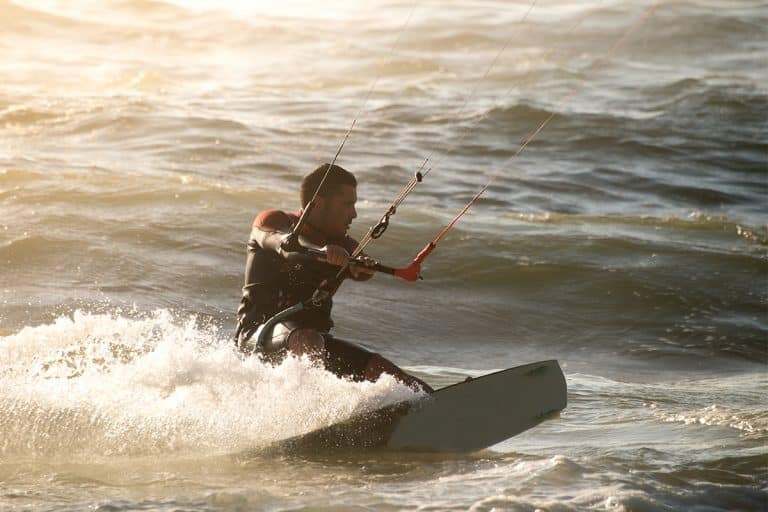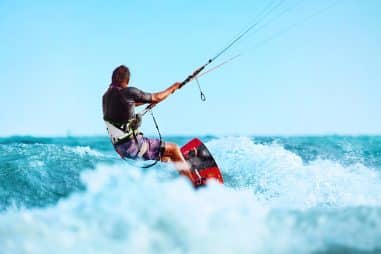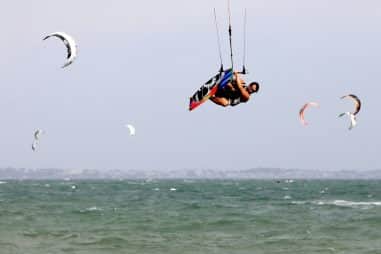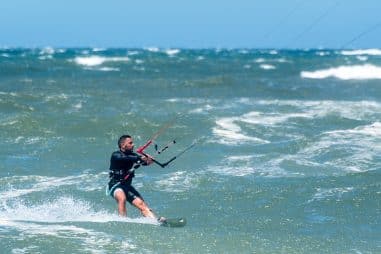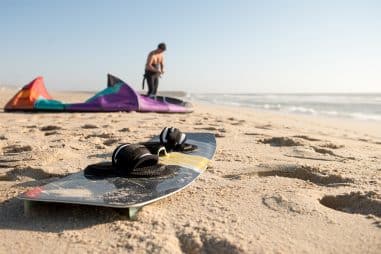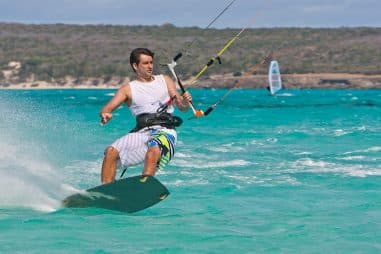Different passionate individuals contribute to the development of kitesurfing that we have today. As kiteboarding continues to evolve up to this day it also borrows inspiration from other board-related sports which gave birth to different riding styles like freeride, freestyle, and wake style. The rich history of the sport, varying riding styles, and complex mechanisms make kiteboarding very intriguing. Read on to find out more about this exciting sport.
How Does a Kiteboard Kite Work?
A distinctive thing about kiteboarding is its mixture of water and wind sport. The science of aerodynamics plays an important part in understanding how kites actually work. Wind alone is not the only reason for the kite to soar, there are a lot of forces affecting the flight of the kite-like lift, drag, thrust, and weight.
- Lift and Weight: Lift is the upward force that causes the kite to float. The kite catches the air going upward which helps you move skyward. Contrastingly there is weight, it is common knowledge that gravity pulls you and your kite downward. This gravitational force that counterbalances the lift or the upward force is the weight.
- Thrust and Drag: In order to move the kiteboarder in a forward motion, tension is produced by the kite and the lines that move you to your destination. And lastly, drag the backward force and often called air resistance.
These factors all contribute to the flight of the kite. Playing around with these components lets you gain speed, slow down, jump high and maneuver while doing kiteboarding. The next time you fly your kite observe how these forces behave and take advantage of this knowledge to improve your kitesurfing.
How Fast Can You Go on a Kiteboard?
An average kitesurfer rides at the speed of 17 to 21 knots or equivalent to 20 to 25 mph. Provided the right wind conditions you can still safely ride at a speed of up to 34 knots or 40 mph using a suitable kite size and board type. Professional kiteboarders usually attain a speed of 52 knots or 60 mph.
The kiteboarding world speed record is 57.97 knots or 66.71 mph set by Alex Caizergues in 2017. He beat his own record of 57.62 knots or 65.16 mph in 2013. To attain this kind of speed it is necessary to have the right kind of speed board, high wind speed, and a very flat-water surface. The Salin-de-Giraud Canal in Arles, France can provide these necessary conditions, which makes it a great venue for the Salt and Sail world record attempt which took place every year.
Who Invented Kiteboarding?
In 1977, Gijsbertus Adrianus Panhuis, an inventor from the Netherlands patented a new water sport called KiteSurfing. Not much commercial attention is given during this early stage of the sport, not until by the mid-eighties when the two brothers, Bruno and Dominique Legaignoux from the coast of France started developing inflatable kites for kiteboarding.
This soon to be celebrated sport continues to evolve in the nineties. Over in the United States, Corey Roesler and his father George Roesler, who is an aerodynamic engineer invented KiteSki. The Roeslers’ invention features a water ski and a delta-type kite. In the late 1990s, the water ski evolved into a single board like the surfboard which we now use for kiteboarding.
What Is the Difference Between Freeride and Freestyle Kiteboarding?
Kiteboarding has a wide variety of riding styles we can enjoy. Freeride is the most common style, but it covers all the different kiteboarding disciplines. Freeride is cruising around water, doing jumps, doing tricks. You can say the freeride is for all ages and everyone who just like to have fun in the water during their spare time.
Freestyle is like a flashy style of freeride and requires a higher skill set. Most of the competitions are freestyle, it is riding fast on water, getting high jumps, catching waves, and doing complex air tricks. It is sometimes hard to tell what style a rider is doing. The distinction between freeride and freestyle is still gray up to now.
What Is Freeride Kiteboarding?
One of the most popular styles is freeride kiteboarding, although it is the most common riding style it covers all different styles. It is the style of kiteboarding and it is anything you want it to be, some riders just want to cruise around, do jumps, and do some freestyle. It’s for kitesurfers who want to have fun no matter what skill level.
Most of the beginners start by doing freeride kiteboarding. Generally, you would want to get a kite and board that is specifically for freeriding if you intend to do freeride. A freeride board is designed to perform well in all conditions and has a rounder outline. Same as the board the kite also is fashioned for all disciplines, these kites have a big wind range and are very easy to use.
What Is Freestyle Kiteboarding?
Some people get into kiteboarding because of its complexity and extreme difficulty. Freestyle riders focus on doing difficult moves and master the more technical part of kiteboarding. Freestyle is for competitive riders who specialize in getting fast, doing stylish air tricks, and getting big jumps. Most competitions that are held for kiteboarding are freestyle.
In terms of equipment, a freestyle board is a little stiffer than a freeride board. This allows the rider to gain extra speed and high jumps to perform cool air tricks. Freestyle kites are designed to make unhooking easier for quick sending of the kite. But even with the best gears, it is always based on the skill level of the kiteboarder to land that difficult but stylish tricks.
What Is Wakestyle Kiteboarding?
Kiteboarding borrowed many features from other established sports. Wakestyle is inspired by wakeboarding but instead of using an expensive boat, it is replaced by a kite to propel through the water. Like wakeboarding, this style cover features like launching off ramps, kickers, raileys, rolls, grabs, and aerial tricks. Wakestyle is mostly enjoyed when riding in cable parks.
The boards for wake style are commonly less flexible, shorter, and feature a larger rocker to allow riders to get a better pop out of the water. Wakeboards usually use a fixed boot rather than a strap which allows you to transfer power from your knee to the board much efficiently. Using boots also secures you to your board and provides more control and stability. You can also recycle your freestyle kite if you already own one, it will work perfectly for wakeboarding or you can use any other all-around kite.
Is Kiteboarding an Olympic Sport?
In 2018, kiteboarding made its debut in the Youth Olympic Games in Buenos Aires. Drury Corneil of the Dominican Republic won the gold medal while Christian Tio of the Philippines and Toni Vodisek of Slovenia tied for the silver. Getting included in this event is a big leap for the kiteboarding society to get the much-needed attention for the Olympics.
Kiteboarding has been approved by The International Olympic Committee for the 2020 Tokyo Olympics but due to the Coronavirus pandemic, we have yet to witness our professional athletes compete in this event. However, kiteboarding is still a part of the upcoming 2024 Olympic Games in Paris, France. The kiteboarding world is very much excited to showcase the talents of different regions that we all can’t wait to see.
Can You Kiteboard in the Rain?
It is possible to kiteboard while raining but it has a lot of drawbacks and needs a lot of precautions. If you feel it just a rain shower and will quickly go away you can just continue kitesurfing but still being vigilant. The rain makes your kite wet and heavier, if the kite is in this condition it will be slower and inefficient.
Getting enough air in your kite can also be a problem as wind patterns also become more unpredictable during the rain. If lightning storms are frequent in your location it is best to immediately stop your kiteboarding and quickly get off the water. This weather often results in big waves and aggressive winds, if you are caught up in a tricky situation don’t be scared to let go of the kite as your safety is of the utmost importance.
Can You Kiteboard on a Lake?
Some lakes are suitable for kitesurfing while most are not. Lakes should be huge enough to allow the launching of kites and riding freely. It is also best to have minimal obstruction like trees or other manmade structures that may entangle the kite wires around the lake. It is also a good practice to examine the wind speed on the lake if it is appropriate for kitesurfing.
If a spot does not generate enough wind speed find another location that can be an effective launching area. Launch away from trees or structures that may tangle your wires. And always keep in mind that before you go kiteboarding on a lake make sure to check the local laws as some areas restrict kite surfing as it may cause risk to the public.

